
views
Learning and Practicing
Learn the solfege system. You may have heard singers sing ascending scales like this: Do Re Mi Fa Sol La Ti Do. (If you haven't, check out this example to learn the intervals between notes: https://www.youtube.com/watch?v=s_pq9s9USmI). "Do" is always assigned to the "tonic" or "root note" of the scale, such as the C in the C major scale or G in a G major scale. By singing the solfege scale ascending from here, you will hit each note in that scale. Some singers reinforce the different syllables by changing hand shape as well. This is optional. A minority of singers prefer other systems, such as "1 2 3 4 5 6 7 1."
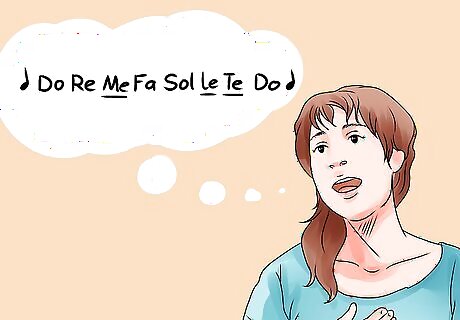
Use solfege for minor scales. This is explained here so you can refer to the solfege system directly above, but you may want to wait until you've got plenty of practice with the solfege system before you try this. In minor scales (which exist in several forms), some of the intervals between notes are lowered from a whole step (such as from C to D) down to a half step (C to C♯). In solfege, these notes halfway between certain intervals are indicated by changing the vowel sound in the solfege syllable. Here are some examples, with the lowered notes in bold: Natural minor: do re me fa sol le te do Harmonic minor: do re me fa sol le ti do Melodic minor, ascending: do re me fa sol la ti do Melodic minor, descending: do te le sol fa me re do The chromatic scale, which goes up only in half steps, includes some syllables that are rarely used in songs. Learning it is not recommended until you are comfortable at sight-singing. Knowing these can help you sight-sing a note in the sheet music that's a half step up or down from the scale you are singing in. These are marked with a sharp symbol ♯ (half step up) or a flat symbol♭(half step down).
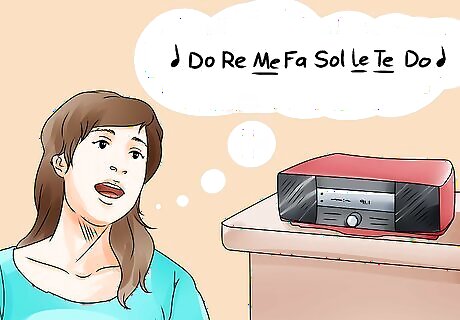
Practice solfege with your favorite songs. Learning solfege is tough, especially without a music teacher to guide you. Practice as often as you can by choosing your favorite songs and trying to identify the "tonic note" of the piece, which you will sing as Do, then sing the entire song in solfege. There are a few ways to find the tonic note: When a note in the song feels like it is "coming home" or reaching a conclusion, this is often the tonic note. Songs often end on this note. Try to play the melody on the piano, while listening to the song. Turn off the music and attempt to sing "Do Re Mi..." while using only the piano keys used for the song. Keep trying different notes for "Do" until you succeed. If you hear an abrupt shift in the emotional tone of the melody, it may have changed keys. Focus on just one section at a time, since changing your "Do" note mid-song can be very tricky for beginners.
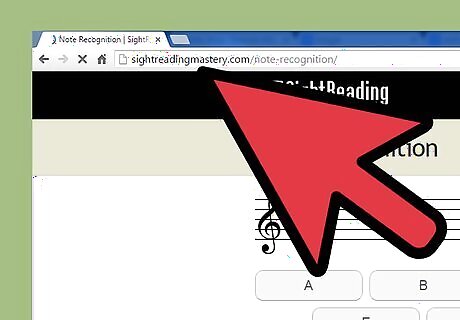
Learn how to read music. It is possible to start from the first note on the page and count the number of spaces and lines up or down to the next note. Learning to read music is a much more efficient way to go about this, and will let you sight-sing faster and smoother. You can start by memorizing the mnemonics below, but to get it to sink in you'll need daily practice, perhaps with an online note recognition tool. In the treble clef, remember the lines from bottom to top by repeating Every Good Boy Does Fine. The spaces between them spell FACE. In the bass clef, remember the lines from bottom to top with Good Boys Do Fine Always. And for the spaces between them: All Cows Eat Grass.

Practice counting from C. This is the note usually used as the baseline note for singers. Play C on a piano, or use a metronome with a pitch function that produces C. Practice singing up or down the scale to find a different note. This is the process you'll use to find the starting note of a song. If you want to train relative pitch, you can try to find a song you know by heart that begins with C, and use it as a baseline. Keep in mind that people often start singing a song in a different key each time, so test yourself with a piano to make sure you can start on the right pitch each time. Alternatively, carry a tuning fork with you and listen to it throughout the day as often as you can. Guess the note, then use the tuning fork to see if you're right.

Practice jumping across intervals. The most important skill for sight-singing is the ability to jump from 1 note to another without making a mistake, even if the 2 notes are nowhere near each other in the scale. Incorporate solfege exercises like the following into your daily practice routine: (low)Do Re Do Mi Do Fa Do Sol Do La Do Ti Do (high)Do Sing a song you know by heart using solfege. Slow down and repeat as necessary until you can sing the whole song using the right syllables. (It helps to sing the solfege scale in the right key a couple times before you begin.) For instance, "Mary Had a Little Lamb" begins with Mi Re Do Re Mi Mi Mi and "Happy Birthday" starts with Sol Sol La Sol Do Ti.

Practice rhythm. One way to do this is to subdivide while listening to a song or reading sheet music. Clap to the beat of the song, but divide each beat into subsections, chanting aloud "1–2" or "1-2-3-4" between each clap. There are apps available, like Rhythm Sight Reading Trainer, that can help you with this.
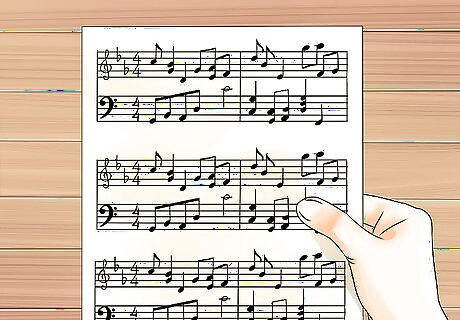
Practice sight-singing. Sight singing is a tough skill, and it requires a great deal of practice to get to the point where you can comfortably sing any sheet music that comes your way. Search online or in libraries for sheet music of unfamiliar songs, attempt to sing them, then check whether you got it right by finding a recording online. Repeat this daily if possible. Sing it with solfege first, then with the lyrics if there are any. Make sure the sheet music is written for your vocal range.
Sight-Singing a Piece of Music
Assess the time signature. The time signature looks like a fraction and is noted at the beginning of a piece of music. The top number tells you how many beats there will be every measure, and the bottom number tells you what kind of notes those beats will be in this song. For instance, if 3 is on top and 1 is on the bottom, there will be 3 whole note beats per measure. If 5 is on top and 2 is on the bottom, there will be 5 half note beats per measure. If 6 is on top and 8 is on the bottom, there will be 6 eighth-note beats per measure. The most common time signature (sometimes just written with the letter C meaning “common time”) is 4 on top and 4 on the bottom, which means there are 4 quarter-note beats per measure.
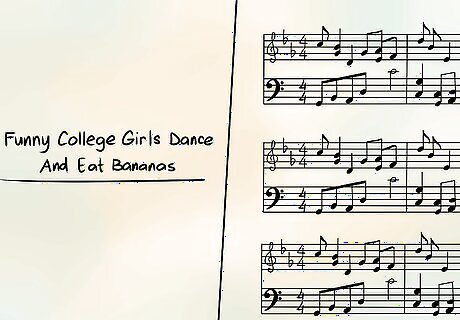
Identify the key. At the beginning of the sheet music, next to the clef sign, sharp ♯ and flat♭signs make up the "key signature." These tricks will help you memorize what each key signature looks like: If there are no sharps or flats next to the clef, the scale is C major or A minor, so C or A will be Do for this song, respectively. The rightmost sharp in the key signature is Ti on the solfege scale. Go up one half step (a space or line) and you'll get the root note which the scale is named for, and which you can think of as Do. Alternatively, use this mnemonic to identify the scale by how many sharps there are (starting at one sharp): Green Day And Elvis Buy Four Cats The rightmost flat in the key signature is Fa, and the flat to its left is the root note Do. Identify the scale by the number of flats there are (starting at one flat): Fat Boys Eat Apples During Geometry Class
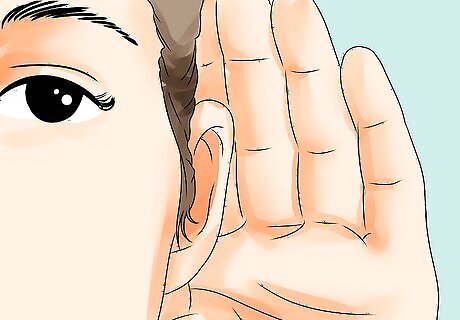
Listen to the root note. Unless you have perfect pitch, you'll need to listen to the root tone. This is always the note in the name of the key signature, so when you're singing a song written in A, you'll want to listen to an A. You can use a piano, a metronome with a pitch function, a tuning fork, or pitch software on a phone app or website.
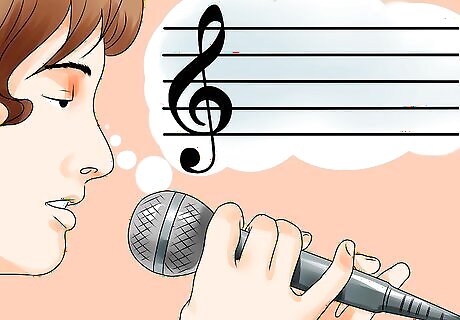
Run through the solfege scale. Using the root note as Do, sing the solfege scale up and down once or twice to get a feel for the notes you'll be singing. Remember to use the minor solfege syllables for minor scales.
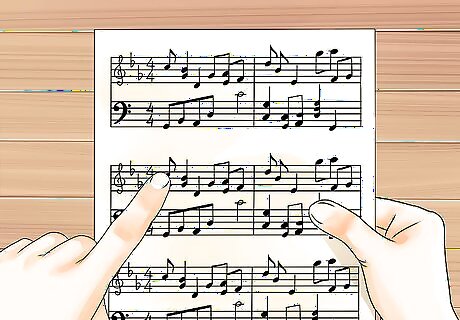
Check the rhythm and tempo. The vertical bar lines on sheet music will help you detect the beat of the music. Tap this onto your leg with your fingers if it helps you get a sense of it. There may also be a tempo mark telling you how fast to sing, such as "90" for 90 beats per minute. Feel free to sing it slower if you need to, unless you are being accompanied. Italian words are often used as tempo descriptions as well, such as andante for a "walking pace" of approximately 90 beats per minute. Allegro for fast and adagio for slow are two of the most common.

Cope with difficult passages. If you are singing alone, especially when you are practicing, slow down slightly when you're having trouble with a passage. If you are being accompanied or singing in a group, lower the volume instead while you're struggling, but keep a confident, clear tone. As you train your sight-singing and get a feel for the song you are singing, even your guesses will be right more and more often. You can use an app like AnyTune to slow down difficult passages in a recording without changing the pitch.




















Comments
0 comment